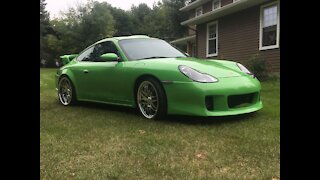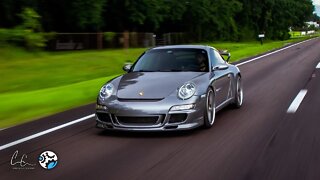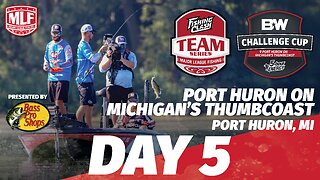Premium Only Content

1973 Porsche 911 2.4L POV
Get Porsche merchandise here... http://geni.us/ftXt
Join this channel to help me bring you more vids...
https://www.youtube.com/channel/UCS-ix9RRO7OJdspbgaGOFiA/join
Join the free von Panda group here... https://panda-research-institute.mn.co
Get Peter von Panda gear here... https://petervonpanda.storenvy.com/
Instagram... https://www.instagram.com/petervonpanda/
As an Amazon Associate I earn from qualifying purchases.
The Porsche 911 (pronounced Nine Eleven or German: Neunelfer) is a two-door, 2+2 high performance classic German sports cars made since 1963[1] by Porsche AG of Stuttgart, Germany. It has a rear-mounted six cylinder boxer engine and all round independent suspension. It has undergone continuous development, though the basic concept has remained little changed.[2] The engines were air-cooled until the introduction of the Type 996 in 1998, with Porsche's "993" series, produced in model years 1994–1998, being the last of the air-cooled Porsches.[3][4]
The Porsche 911 (pronounced Nine Eleven or in German: Neunelfer) is a two-door, 2+2 high performance rear-engined sports car made since 1963[1] by Porsche AG of Stuttgart, Germany. It has a rear-mounted flat-six engine and all round independent suspension. It has undergone continuous development, though the basic concept has remained unchanged.[2] The engines were air-cooled until the introduction of the Type 996 in 1998, with the 993, produced from 1994–1998 model years, being the last of the air-cooled Porsche sports cars.[3][4]
The 911 has been modified by private teams and by the factory itself for racing, rallying, and other forms of automotive competition. It is among the most successful competition cars. In the mid-1970s, the naturally aspirated 911 Carrera RSR won major world championship sports car races, such as Targa Florio and 24 Hours of Daytona, even against prototypes. The 911-derived 935 turbo also won the 24 Hours of Le Mans in 1979 and Porsche won World Championship for Makes titles in 1976, 1977, 1978 and 1979 with 911-derived models.
In the 1999 international poll to determine the Car of the Century, the 911 came fifth.[5] It is one of two in the top five that had remained continuously in production (the original Beetle remained in production until 2003),[6] and was until 1998 a successful surviving application of the air- (now water-) cooled opposed rear-engine layout pioneered by its ancestor, the Porsche 356. It is one of the oldest sports coupé nameplates still in production with one million manufactured as of May 2017.[7]
911 Carrera RS (1973 and 1974)
1973 Porsche 911 Carrera RS
Porsche 911 Carrera RS 2.7 touring
RS stands for Rennsport in German, meaning race sport. The Carrera name was reintroduced from the 356 Carrera which had itself been named after Porsche's class victories in the Carrera Panamericana races in Mexico in the 1950s. The RS was developed to meet motorsport homologation requirements. Compared to a standard 911S, the Carrera 2.7 RS had a larger engine (2,687 cc) developing 210 PS (150 kW; 210 hp) with Bosch (Kugelfischer) mechanical fuel injection, revised and stiffened suspension, a "ducktail" rear spoiler, larger brakes, wider rear wheels and rear fenders, to fit 185/70VR15 & 215/60VR15 Pirelli Cinturato CN36 tyres. In RS Touring form it weighed 1,075 kg (2,370 lb), in Sport Lightweight form it was about 100 kg (220 lb) lighter, the saving coming from thin gauge steel used for parts of the body shell and also the use of thinner glass. In total, 1,580 units were made, and qualified for the FIA Group 4 class. 49 Carrera RS cars were built with 2,808 cc (2.8 L) engines rated at 300 PS (220 kW; 300 hp).
The 911 RSR
For the 1974 IROC Championship (which started in December 1973), 1973 Carrera RSR models were fitted with the 3.0 engine and a flat "whale tail" in place of the ducktail spoiler along with wide body panels and large tyres.
In 1974, Porsche developed the Carrera RS 3.0 with mechanical fuel injection rated at 230 PS (170 kW; 230 hp). Its price was almost twice that of the 2.7 RS, but it offered racing capability. The chassis was largely similar to that of the 1973 Carrera RSR and the braking system was from the 917 racing car. The use of thinner metal plate panels and a minimalist interior enabled its weight to be reduced to around 900 kg (2,000 lb).
The Carrera RSR 3.0 was sold to racing teams and scored wins in several major sports car races of the mid-1970s. Also, a prototype Carrera RSR Turbo (with 2.1-litre engine due to a 1.4x equivalency formula) came second at the 24 Hours of Le Mans in 1974 and won several major races, a significant event in that its engine would form the basis of many future Porsche attempts in sports car racing. This, and the earlier 917, was Porsche's commitment to turbocharger applications in its cars.
-
 0:47
0:47
Peter von Panda
1 year agoInstant Sinus Relief with Menthol Crystals A Natural Wake Up Call!
519 -
 0:09
0:09
Porsche 911 cruise
3 years agoPorsche 911
92 -
 3:46
3:46
CC Detailing
3 years ago997.1 Porsche 911 Carrera
144 -
 LIVE
LIVE
Major League Fishing
6 days agoLIVE! - Fishing Clash Team Series: Challenge Cup - Day 5
394 watching -
 1:49:30
1:49:30
The Quartering
3 hours agoCount Dankula Live On Migrant Crisis In Europe, Whiteness & More
107K117 -
 3:46:59
3:46:59
Barry Cunningham
7 hours agoBREAKING NEWS: KAROLINE LEAVITT HOLDS WHITE HOUSE PRESS CONFERENCE (AND MORE NEWS)
61.9K41 -
 47:21
47:21
Stephen Gardner
20 hours ago🔥Elon Just Exposed the Most Corrupt Man on Earth - Trump Makes BOLD MOVE!
21K96 -
 LIVE
LIVE
The HotSeat
1 hour agoI'm NOT Sorry! Guns Aren’t the Problem—Godless Culture Is
607 watching -
![[Ep 737] Media & Left Attack Prayer and God | Media Loses Control of Narrative | CDL Fraud](https://1a-1791.com/video/fww1/ca/s8/1/m/N/f/d/mNfdz.0kob-small-Ep-736-Make-Gender-Dysphori.jpg) LIVE
LIVE
The Nunn Report - w/ Dan Nunn
1 hour ago[Ep 737] Media & Left Attack Prayer and God | Media Loses Control of Narrative | CDL Fraud
189 watching -
 2:53:12
2:53:12
Right Side Broadcasting Network
7 hours agoLIVE REPLAY: White House Press Secretary Karoline Leavitt Holds a Press Briefing - 8/28/25
111K43